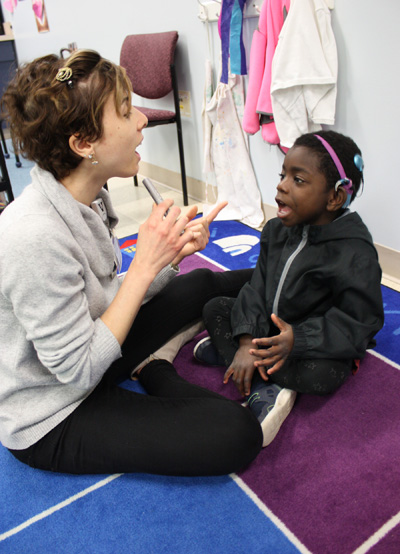Children with hearing loss who use remote microphone systems (RMS) at home have access to about 42 percent more words each day, providing a critical boost to vocabulary and language learning, a Vanderbilt study has found.
The study, published in the Journal of Speech, Language, and Hearing Research, is one of the first to measure caregiver talk in the homes of children with hearing loss who use RMS. An RMS involves the wearing of a microphone by the speaker and a receiver by the child. The speaker’s voice is transmitted to the receiver and is amplified for the child without amplifying any background noise.

These systems are commonly used in school settings. However, the study results suggest that children with hearing loss could be missing out on a significant amount of speech from their parents, and that RMS could have many more applications than just in an educational setting.
Earlier research shows that there is a positive relationship between the number of words to which children are exposed and their resultant vocabulary, note the authors, Vanderbilt PhD student Carlos Benítez-Barrera, Vanderbilt audiologist Gina Angley, AuD, and Anne Marie Tharpe, PhD, chair of the Department of Hearing and Speech Sciences and associate director of the Vanderbilt Bill Wilkerson Center.
The study is one of the latest to come out of the Department of Hearing and Speech Sciences, where two of its graduate programs just ranked No. 1 in U.S. News & World Report rankings —audiology and speech-language pathology.
To measure speech, the study outfitted 10 families with RMS over the course of a weekend, which broadcast speech directly from the caregiver to the child’s hearing aids or cochlear implants. In addition, parents and children wore recording devices to determine how much they spoke, using language environment analysis software, and how much reached the child’s recorder. The following weekend, the RMS devices were not used but the recording devices were.
“It allowed us an opportunity to see how much speech from a caregiver a child misses if they are not using this system in the home,” Tharpe said. “If the caregiver was greater than about 8 feet from the child, the child’s recorder did not pick up the speech. By comparing the speech on both the caregiver’s and the child’s recorders, we could calculate how much speech was picked up if they did use an RMS.”
RMS systems are designed to overcome three acoustic barriers — background noise, reverberation and distance. The study found that caregivers tended to speak much more from a distance on the weekend using the devices, meaning that the device enabled children to hear their parents not just when they were nearby. This exposed children to valuable passive speech rather than face-to-face speech and opened more natural opportunities for language, Tharpe said.
“That was interesting to us, because it implied that parents actually understood that they could be more natural in their communication with children, that they could go into the kitchen and be making dinner and talk to their child, who might be at the dining room table or playing on the floor,” Tharpe said.
In so doing, it allowed the children with hearing loss to hear things that normal-hearing children take for granted.
“Children learn by listening to conversations that their parents are having,” Tharpe said. “They’re listening to negotiations between their parents. They’re learning not only vocabulary — which we know children can learn passively as well as actively — but they’re also learning social skills, and if they’re not hearing those conversations, it’s very difficult for them to learn rules of social engagement and the vocabulary associated with those interactions.”
Tharpe said it is not just important for children to hear words — such as from the television — it’s important to hear words directed to them from their parents and engage in conversation. However, it’s difficult for that to occur when parents have to stop what they’re doing to move into close proximity with children. The RMS “allows families to be able to continue to talk while they’re doing other things like making dinner, folding laundry, whatever it is that people are doing,” Tharpe said.
“The next step in this work is to conduct additional coding of the recordings for further analysis,” said Benítez-Berrera. “Next we will analyze the communication patterns between the parents and children in home settings.”















